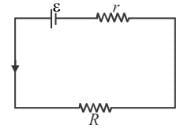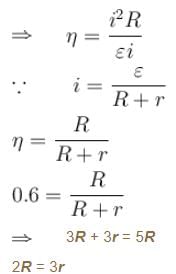Physics Exam > Physics Questions > The efficiency of a cell when connected to a ...
Start Learning for Free
The efficiency of a cell when connected to a resistance R is 60%. What will be its efficiency (in %) if the external resistance is increased to six times.
Correct answer is '90'. Can you explain this answer?
| FREE This question is part of | Download PDF Attempt this Test |
Verified Answer
The efficiency of a cell when connected to a resistanceR is 60%. What ...



The correct answer is: 90
Most Upvoted Answer
The efficiency of a cell when connected to a resistanceR is 60%. What ...
Efficiency of a Cell with Resistance R:
The efficiency of a cell is defined as the ratio of useful output power to the input power. In this case, the useful output power is the power delivered to the external resistance R, and the input power is the power supplied by the cell.
Given:
Efficiency with resistance R = 60%
Formula for Efficiency:
Efficiency = (Useful output power / Input power) * 100
Efficiency Calculation:
Let's assume the power supplied by the cell is P.
Useful output power = Power delivered to resistance R = P * I (where I is the current flowing through the resistance R)
Input power = Power supplied by the cell = P
Using the formula for efficiency, we have:
Efficiency = (P * I / P) * 100 = I * 100
Effect of Increasing Resistance:
Now, let's consider the case when the external resistance is increased to six times its initial value.
If the resistance is increased, the current flowing through the circuit will decrease according to Ohm's Law (V = IR). As a result, the power delivered to the resistance will also decrease.
Efficiency Calculation with Increased Resistance:
Let's assume the new resistance is 6R.
If the external resistance is 6R, the current flowing through the circuit will be I/6, according to Ohm's Law.
Therefore, the new efficiency can be calculated as follows:
Efficiency = (I/6) * 100 = I * (100/6) = (1/6) * 100 = 16.67%
Conclusion:
The efficiency of the cell decreases to 16.67% when the external resistance is increased to six times its initial value. This decrease in efficiency is due to the decrease in current flowing through the circuit.
The efficiency of a cell is defined as the ratio of useful output power to the input power. In this case, the useful output power is the power delivered to the external resistance R, and the input power is the power supplied by the cell.
Given:
Efficiency with resistance R = 60%
Formula for Efficiency:
Efficiency = (Useful output power / Input power) * 100
Efficiency Calculation:
Let's assume the power supplied by the cell is P.
Useful output power = Power delivered to resistance R = P * I (where I is the current flowing through the resistance R)
Input power = Power supplied by the cell = P
Using the formula for efficiency, we have:
Efficiency = (P * I / P) * 100 = I * 100
Effect of Increasing Resistance:
Now, let's consider the case when the external resistance is increased to six times its initial value.
If the resistance is increased, the current flowing through the circuit will decrease according to Ohm's Law (V = IR). As a result, the power delivered to the resistance will also decrease.
Efficiency Calculation with Increased Resistance:
Let's assume the new resistance is 6R.
If the external resistance is 6R, the current flowing through the circuit will be I/6, according to Ohm's Law.
Therefore, the new efficiency can be calculated as follows:
Efficiency = (I/6) * 100 = I * (100/6) = (1/6) * 100 = 16.67%
Conclusion:
The efficiency of the cell decreases to 16.67% when the external resistance is increased to six times its initial value. This decrease in efficiency is due to the decrease in current flowing through the circuit.

|
Explore Courses for Physics exam
|

|
Similar Physics Doubts
The efficiency of a cell when connected to a resistanceR is 60%. What will be its efficiency (in %) if the external resistance is increased to six times.Correct answer is '90'. Can you explain this answer?
Question Description
The efficiency of a cell when connected to a resistanceR is 60%. What will be its efficiency (in %) if the external resistance is increased to six times.Correct answer is '90'. Can you explain this answer? for Physics 2024 is part of Physics preparation. The Question and answers have been prepared according to the Physics exam syllabus. Information about The efficiency of a cell when connected to a resistanceR is 60%. What will be its efficiency (in %) if the external resistance is increased to six times.Correct answer is '90'. Can you explain this answer? covers all topics & solutions for Physics 2024 Exam. Find important definitions, questions, meanings, examples, exercises and tests below for The efficiency of a cell when connected to a resistanceR is 60%. What will be its efficiency (in %) if the external resistance is increased to six times.Correct answer is '90'. Can you explain this answer?.
The efficiency of a cell when connected to a resistanceR is 60%. What will be its efficiency (in %) if the external resistance is increased to six times.Correct answer is '90'. Can you explain this answer? for Physics 2024 is part of Physics preparation. The Question and answers have been prepared according to the Physics exam syllabus. Information about The efficiency of a cell when connected to a resistanceR is 60%. What will be its efficiency (in %) if the external resistance is increased to six times.Correct answer is '90'. Can you explain this answer? covers all topics & solutions for Physics 2024 Exam. Find important definitions, questions, meanings, examples, exercises and tests below for The efficiency of a cell when connected to a resistanceR is 60%. What will be its efficiency (in %) if the external resistance is increased to six times.Correct answer is '90'. Can you explain this answer?.
Solutions for The efficiency of a cell when connected to a resistanceR is 60%. What will be its efficiency (in %) if the external resistance is increased to six times.Correct answer is '90'. Can you explain this answer? in English & in Hindi are available as part of our courses for Physics.
Download more important topics, notes, lectures and mock test series for Physics Exam by signing up for free.
Here you can find the meaning of The efficiency of a cell when connected to a resistanceR is 60%. What will be its efficiency (in %) if the external resistance is increased to six times.Correct answer is '90'. Can you explain this answer? defined & explained in the simplest way possible. Besides giving the explanation of
The efficiency of a cell when connected to a resistanceR is 60%. What will be its efficiency (in %) if the external resistance is increased to six times.Correct answer is '90'. Can you explain this answer?, a detailed solution for The efficiency of a cell when connected to a resistanceR is 60%. What will be its efficiency (in %) if the external resistance is increased to six times.Correct answer is '90'. Can you explain this answer? has been provided alongside types of The efficiency of a cell when connected to a resistanceR is 60%. What will be its efficiency (in %) if the external resistance is increased to six times.Correct answer is '90'. Can you explain this answer? theory, EduRev gives you an
ample number of questions to practice The efficiency of a cell when connected to a resistanceR is 60%. What will be its efficiency (in %) if the external resistance is increased to six times.Correct answer is '90'. Can you explain this answer? tests, examples and also practice Physics tests.

|
Explore Courses for Physics exam
|

|
Suggested Free Tests
Signup for Free!
Signup to see your scores go up within 7 days! Learn & Practice with 1000+ FREE Notes, Videos & Tests.


















